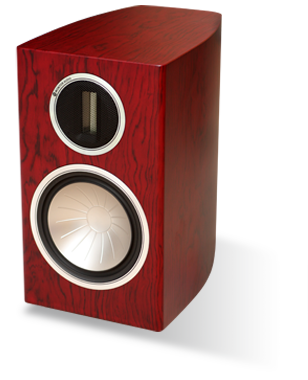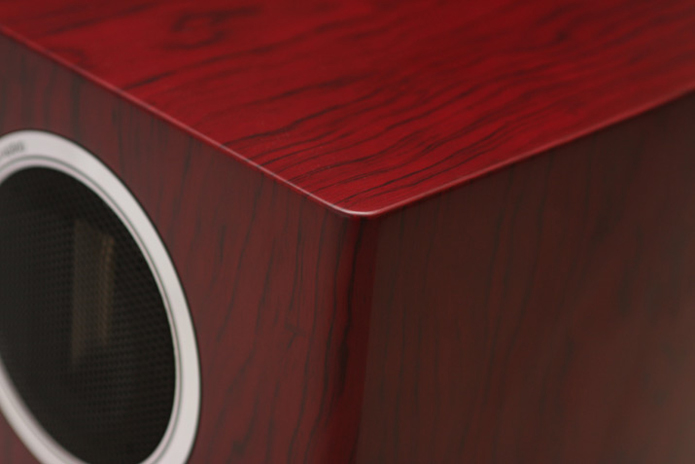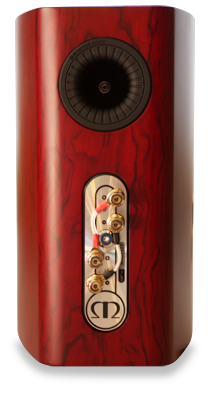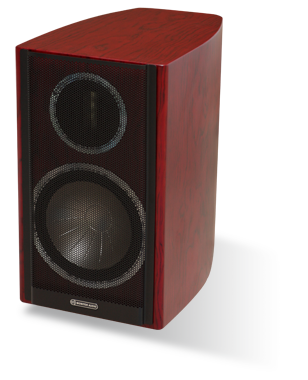Note: Measurements taken in the anechoic chamber at Canada's National Research Council can be found through this link.

 They say a picture is worth a thousand words. That might be true for some things, but not for Monitor Audio’s Gold GX100 loudspeaker. In every photo I’ve seen of the speaker, it’s looked, at best, ho-hum. Imagine my surprise, then, when I unboxed the review pair and discovered two of the most exquisite-looking, best-finished cabinets I’ve seen on any speaker near this price, or even double it. With most speakers, the first thing I do is rush to set them up. With these, I just wanted to sit back and look.
They say a picture is worth a thousand words. That might be true for some things, but not for Monitor Audio’s Gold GX100 loudspeaker. In every photo I’ve seen of the speaker, it’s looked, at best, ho-hum. Imagine my surprise, then, when I unboxed the review pair and discovered two of the most exquisite-looking, best-finished cabinets I’ve seen on any speaker near this price, or even double it. With most speakers, the first thing I do is rush to set them up. With these, I just wanted to sit back and look.
What’s more, while Monitor Audio is based in the UK, they now have their speakers made in China, as do many of their competitors. From what I’ve heard, many of these companies are having problems with quality control and workmanship. My first impression of the Gold GX100 was that Monitor is having no such problems -- not only does this speaker look so good that no picture out there can do it justice, its appearance is miles better than that of Monitor models of yore. Of course, the most important question for the audiophile is whether they sound as good as they look. I’m getting to that . . .
Description
The Gold GX100 ($2195 USD per pair) is one of two bookshelf models in Monitor Audio’s Gold GX line, which includes a smaller bookshelf (GX50), two floorstanders (GX200 and GX300), two center-channels (GXC150 and GXC350), a surround (GXFX), and a subwoofer (GXW15). These replace the Gold GS line, and fall just below Monitor Audio’s flagship Platinum line. However, given that the Gold GXes were introduced after the Platinums, it appears they’ve benefited from technology trickled down from the top of the Monitor hierarchy.

For example, whereas the GS models had gold dome tweeters, the GX speakers have ribbon tweeters similar to those found in the Platinums. Just like the Platinum tweeters, the Gold GX ribbons are made of C-CAM, Monitor’s proprietary alloy of aluminum and magnesium, with an electroplated coating of ceramic. In this process, an electrical current is used to bond ceramic alumina to the alloy. Apparently, C-CAM-type technology was originally developed for use in jet-engine components, but its rigidity and low density also make it a good material for building speaker drivers. With a mass of just 18mg, the tweeter’s diaphragm is suspended in a magnetic field produced by high-energy neodymium magnets. According to Monitor, the tweeter’s output extends all the way up to 60kHz -- not as high as the 100kHz cutoff claimed for the Platinum tweeters, but still well beyond the 20kHz upper limit of human hearing. (If you’re old enough to be reading this review, you’ve probably already lost the ability to hear all the way up to 20kHz.)
The C-CAM diaphragm of the GX100’s 6.5" midrange-woofer employs Monitor’s Rigid Surface Technology (RST), which includes a series of ribs across the cone’s surface. Apparently the ribs measurably improve the cone’s stiffness, helping it resist breakup and thereby reducing distortion. The additional strength conferred by the ribs also means that the cone can be made thinner, reducing its weight and improving its ability to start and stop instantaneously.
Another advantage of making cones of lighter materials is that they’re easier to drive, as demonstrated by the Gold GX100’s amplifier-friendly 88dB sensitivity and nominal impedance of 8 ohms. The speaker is a two-way design; the drivers are crossed over at 2.7kHz, and Monitor says they’re capable of producing a frequency response of 42Hz-60kHz -- a wide bandwidth, particularly for a bookshelf model.
The GX100’s cabinet measures 14 3/8"H x 8 1/4"W x 11 15/16"D and weighs just under 22 pounds. It seemed sturdily built, very solid, and impressively rigid, due in part to the fact that each driver is housed in its own discrete enclosure, which not only keeps them separated from each other but also helps brace the box. A good rap of a knuckle on a side panel produced only a dull thud.
The review pair came finished in Bubinga real-wood veneer. Also available are Dark Walnut and Natural Oak real wood, Piano Black or Piano White lacquer, and Piano Ebony. The finish was flawless; with the wood’s warm, reddish glow and the cabinet’s soft, rounded edges, the GX100s had the appearance of fine furniture. The craftsmanship was superb, with careful attention to detail. The drivers are mounted so that none of the hardware shows; instead, tweeter and midrange-woofer are each surrounded by a polished metal ring that seems a more modern touch, while retaining the elegance of the overall design. The cabinet narrows toward the back, to prevent standing waves from forming inside; it also makes the GX100 slimmer and less obtrusive.
The metal grilles seem to be secured magnetically -- and magically -- to the wood veneer. The receiving magnets are installed under the veneer -- when the grilles are removed, again, no mounting hardware is visible. The GX100 looks great, but I didn’t feel that way about its grille; a grilleless GX100 looks very clean, so that’s how I listened to them.
 On the rear of the GX100 are two pairs of the nicest-looking, highest-quality binding posts I’ve seen; they accept spades, banana plugs, or bare wire, so the GX100s can be biwired or biamped. If you need only one set of binding posts (as I did), an impressive pair of spade-terminated jumper cables is supplied. Above the speaker-wire connectors is a large port whose shape is designed to increase the rate of airflow and reduce turbulence. This shape, which Monitor calls their HiVe II technology, is claimed to produce faster bass and improve transient response. Port plugs are included, in case your room requires you to tame the GX100s’ bass output. I didn’t use them.
On the rear of the GX100 are two pairs of the nicest-looking, highest-quality binding posts I’ve seen; they accept spades, banana plugs, or bare wire, so the GX100s can be biwired or biamped. If you need only one set of binding posts (as I did), an impressive pair of spade-terminated jumper cables is supplied. Above the speaker-wire connectors is a large port whose shape is designed to increase the rate of airflow and reduce turbulence. This shape, which Monitor calls their HiVe II technology, is claimed to produce faster bass and improve transient response. Port plugs are included, in case your room requires you to tame the GX100s’ bass output. I didn’t use them.
I set up the GX100s atop 24"H Osiris stands. They were connected to a Bryston B100 SST integrated amplifier with AudioQuest Type 4 speaker cable terminated in banana plugs. An NAD C542 CD player served as a transport, sending the digital bitstream from CDs to the DAC aboard the Bryston B100 via an AMX Optimum AVC31 coaxial cable. I played LPs on a Thorens TD-160HD turntable with Rega RB250 tonearm and Dynavector DV-10X5 high-output moving-coil cartridge, and wirelessly streamed music from my Apple iMac computer through an Apple Airport Extreme to an Apple Airport Express. An XtremeMac XtremeHD TosLink cable connected the Express to the Bryston’s DAC. Everything was plugged into an ExactPower EP15A power-line conditioner-regenerator.
Gold standard
The Gold GX100 is the first speaker I’ve reviewed that has a ribbon tweeter. I was interested to hear how it might distinguish itself from the metal-dome tweeters with which I’m most familiar. During my time with the Monitor Audios, I put them through their paces with a selection of music ranging from bluegrass to classical to hip-hop to folk to electronic to straight-up rock’n’roll. I consistently heard a very crisp sound with detailed, incisive highs that portrayed instruments and voices with precision and distinction.
Listening through the GX100s to "Louis Collins," from Jerry Garcia and David Grisman’s excellent Shady Grove (CD, Acoustic Disc ACD-21), was a treat. This tune features acoustic and bass guitar, banjo, and mandolin, and the Monitors presented the strings of this bluegrass band with pristine clarity and twang. The character of each instrument and its location on the stage were easy to discern, and the music resonated with an infectious liveliness that never became bright or harsh.
While the GX100 didn’t sound bright, it had a lively character that was no doubt due to its good extension in the highs. There was a rightness to the top end that wavered only when the recording itself was poor. The GX100 was good at playing whatever was on the disc, which is how I prefer it. They didn’t add space or clarity to a recording if it wasn’t there to begin with, but were pretty good at relaying the signal fed them. In "Hard Times in New York Town," from Bob Dylan’s The Bootleg Series Vol.9 -- The Witmark Demos: 1962-1964 (CD, Columbia 88697 76179 2), the notes sprang from the metal strings of Dylan’s acoustic guitar, and his voice was very clean, if rather two-dimensional. The GX100s did a fine job of capturing the character of Dylan’s voice, but they sounded lean in the process. However, this wasn’t a function of the speakers, but of the character of these rather crude recordings; through the Monitor Audios I was able to hear things as they were, for better or for worse.
In addition to its extended and engagingly lively highs, the GX100 excelled at transparency. Though not the most detailed or revealing speaker I’ve ever heard, it managed a superb balance, sounding open and resolving but never analytical or dry. "Te Amo," from Atlas Sound’s Parallax (CD, 4AD 3130-2), was beautifully sorted and well delineated through the GX100. This track features keyboards layered over looped drums and beats that sound a touch more forward in the mix than Bradford Cox’s slightly recessed, reverberating voice. The Monitor Audios did a fine job of allowing me to hear deep into the track, immersing me in the sound. Likewise, the lively top end of the title track gave it an immediacy that I couldn’t help being drawn into. The result was a detailed, engaging listening experience.
 As impressed as I was by the GX100’s ribbon tweeter, I was equally impressed by its midrange-woofer, which, in conjunction with its solidly constructed cabinet, helped the speaker deliver deep, powerful bass. When I closed my eyes, I could have sworn I was hearing a pair of floorstanders. It wasn’t simply that I felt the bass; it was the clarity and punchiness that let me appreciate that bass’s character. The low end of "Yeah You," from Shabazz Palaces’ Black Up (CD, Sub Pop 98787 09002), was well served by the Monitor Audios, whose output capabilities had no trouble keeping up with this track’s deep electronic bass. Even at high volumes the sound remained composed and powerful, a clear indication that I was nowhere near reaching the speakers’ output limits. If you want to throw a house party with these speakers, go right ahead.
As impressed as I was by the GX100’s ribbon tweeter, I was equally impressed by its midrange-woofer, which, in conjunction with its solidly constructed cabinet, helped the speaker deliver deep, powerful bass. When I closed my eyes, I could have sworn I was hearing a pair of floorstanders. It wasn’t simply that I felt the bass; it was the clarity and punchiness that let me appreciate that bass’s character. The low end of "Yeah You," from Shabazz Palaces’ Black Up (CD, Sub Pop 98787 09002), was well served by the Monitor Audios, whose output capabilities had no trouble keeping up with this track’s deep electronic bass. Even at high volumes the sound remained composed and powerful, a clear indication that I was nowhere near reaching the speakers’ output limits. If you want to throw a house party with these speakers, go right ahead.
The low end in "To Care Like You," from James Blake (CD, Atlas/A&M ATLAS02), another album with powerful synthesized bass, is a bit staggering and digs really deep. As I’d come to expect from them by this point, the GX100s were fully up to the challenge, filling my room with warm bass drones that provided a foundation against which the sparse voices were projected with excellent clarity and resolution, occupying precise outlines on the stage. This is an impressive feat. The GX100s were pretty unflappable under conditions that would have pushed to their limits the output capabilities of lesser speakers. I think this speaks to how well built they are, and to the robust quality of their drivers.
It’s fun to try to punish speakers that can handle some abuse. I pulled out a recording I frequently use in reviews: War Dance, from the suite from Respighi’s Belkis, Queen of Sheba, performed by Eiji Oue and the Minnesota Orchestra (CD, Reference RR-95CD). The sound of the flute over the marching drumbeat offers the most splendid juxtaposition of sentiments spread across a wide, deep soundstage. This track’s bone-rattling dynamic swings were vividly portrayed by the Monitor Audios, which took me on an aural roller-coaster ride. In War Dance, the quiet moments are short-lived; at one point it sounds as if it could have been the score of an old Western -- its incredible pace and rhythm have a tremendous sense of urgency. The GX100s did a fine job of communicating this recording’s dynamic shifts, giving them all the energy they deserve, and reproducing punchy yet full bass with rapid-fire precision.
Comparison
I had on hand for comparison Amphion’s Argon3L speakers. At $3695/pair for the painted finishes ($3995 for real-wood veneers), the Argon3L isn’t directly comparable with the $2195/pair Monitor Audio Gold GX100. More important, the Amphion is a floorstander, and therefore has a much greater cabinet volume than the GX100. Whereas the GX100 has a ribbon tweeter, the Argon3L has a 1" titanium-dome tweeter mounted inside a deep waveguide that, among other things, helps control the driver’s dispersion while increasing the speaker’s sensitivity.
The most obvious area in which the British and Finnish speakers distinguished themselves was the bass. Though the Monitor produced an amazing amount of bass for a bookshelf model, it was no match for the Argon3L, which is no slouch in this department. When I played Shabazz Palaces’ Black Up, the Monitors had no problem filling my room with low-end frequencies that provided more than enough of a foundation for this music. But if the GX100s filled the room with bass, the Argon3Ls flooded it, delivering lows that went deeper with greater weight. Still, the GX100s performed extremely well in the bass, and will likely produce more than enough low end for many listeners’ tastes. If you want fuller-range performance, you’ll have to add a subwoofer or buy a floorstanding model.
Both the GX100’s ribbon and the Argon3L’s titanium dome were exceptionally good at producing crisp, detailed highs, and precisely carved out the leading edges of notes. The various stringed instruments on Garcia and Grisman’s Shady Grove were reproduced very cleanly by both speakers. The Monitors seemed to infuse this bluegrass album with a bit more energy, however, and the liveliness of the top end gave the music an extra dose of presence. Furthermore, Garcia’s voice sounded a touch closer through the Monitors, as if he’d hitched his chair a bit nearer to me.
As for transparency, I found that the Amphion uncovered a little more detail and served up that last bit of resolution slightly better than the Monitor did. However, the Argon3L is probably the most resolving speakers I’ve ever reviewed; the fact that the GX100 wasn’t too far behind says a great deal about how well it acquitted itself. I doubt anyone would choose one over the other based on this parameter.
Monitor Audio’s Gold GX100 and Amphion’s Argon3L are both highly accomplished speakers that I consider at the tops of their classes. Each is extremely well built and offers reference sound. Although I don’t imagine anyone finding him- or herself trying to choose between these two models, I have no doubt that either would make an excellent choice, depending on that listener’s needs, listening space, and budget.
Conclusions
The Gold GX100 has been my second experience with a speaker from Monitor Audio, and again I’ve been smitten with the speaker’s wide range of talents. Not only does the GX100 look like a piece of fine furniture, it sounds superlative from top to bottom. Based on my experience, it is a true reference product; that is, someone will have to spend significantly more for only small improvements in performance. I found its sound highly engaging, and capable of holding my interest. I was able to sustain my utter enthusiasm for its sound for long periods without ever getting fatigued. $2195 isn’t cheap for a pair of speakers, but the buyer of a pair of Gold GX100s will be rewarded with something he or she can own and cherish for many years. Highly recommended.
. . . Philip Beaudette
philipb@soundstagenetwork.com
Associated Equipment
- Speakers -- Amphion Argon3L
- Integrated amplifier -- Bryston B100 SST
- Sources -- NAD C542 CD player; Thorens TD-160HD turntable, Rega RB250 tonearm, Dynavector DV-10X5 high-output moving-coil cartridge; Apple iMac computer, Apple Airport Extreme, Apple Airport Express
- Speaker cables -- AudioQuest Type 4
- Interconnects -- AudioQuest Copperhead, AMX Optimum AVC 31 coaxial, XtremeMac XtremeHD TosLink
- Power conditioner -- ExactPower EP15A
Monitor Audio Gold GX100 Loudspeakers
Price: $2195 USD per pair.
Warranty: Five years parts and labor.
Monitor Audio Ltd.
24 Brook Road
Rayleigh, Essex SS6 7XL
England, UK
Phone: +44 1268-740580
Fax: +44 1268-740589
E-mail: info@monitoraudiousa.com
Website: www.monitoraudiousa.com
North American distributor:
Kevro International
902 McKay Road #4
Pickering, Ontario L1W 3X8
Canada
Phone: (800) 667-6065, (905) 428-2800
Fax: (905) 428-0004
E-mail: mrginn@kevro.com
Website: www.kevro.com






















